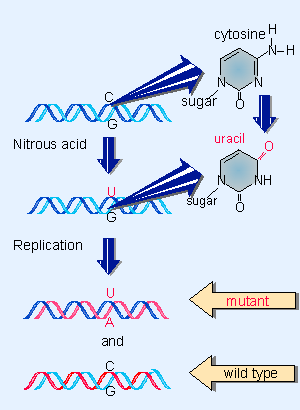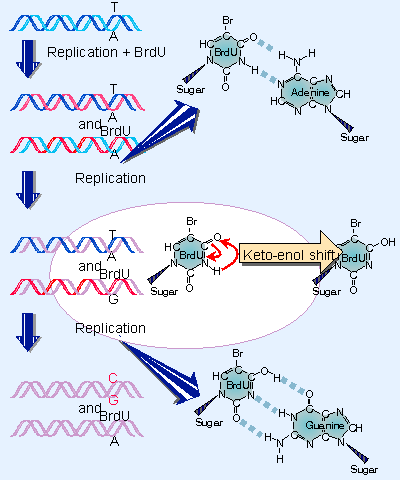6. Mutations change the sequence of DNA
1.6 Mutations change the sequence of DNA |
| Key terms defined in this section |
| Background level of mutation describes the rate at which sequence changes accumulate in the genome of an organism. It reflects the balance between the occurrence spontaneous mutations and their remomval by repair systems, and is characteristic for any species. Deletions are generated by removal of a sequence of DNA, the regions on either side being joined together. Induced mutations result from the action of a mutagen (which may act directly on the bases in DNA) or indirectly, but in either case the result is a change in the sequence of DNA. Insertions are identified by the presence of an additional stretch of base pairs in DNA. Leaky mutants have some residual function, either because the mutant protein is partially active (in the case of a missense mutation), or because a small amount of wild-type protein is made (in the case of a nonsense mutation). Mutagens increase the rate of mutation by inducing changes in DNA sequence, directly or indirectly. Point mutations are changes involving single base pairs. Revertants are derived by reversion of a mutant cell or organism. Spontaneous mutations occur as the result of natural effects, due either to mistakes in DNA replication or to environmental damage. Suppression describes the occurrence of changes that eliminate the effects of a mutation without reversing the original change in DNA. Suppressor (extragenic) is usually a gene coding a mutant tRNA that reads the mutated codon either in the sense of the original codon or to give an acceptable substitute for the original meaning. Transition is a mutation in which one pyrimidine is substituted by the other or in which one purine is substituted for the other. Transversion is a mutation in which a purine is replaced by a pyrimidine or vice versa. |
Mutations provide decisive evidence that DNA is the genetic material. When a change in the sequence of DNA causes an alteration in the sequence of a protein, we may conclude that the DNA codes for that protein. Furthermore, a change in the phenotype of the organism may allow us to identify the function of the protein. The existence of many mutations in a gene may allow many variant forms of a protein to be compared, and a detailed analysis can be used to identify regions of the protein responsible for individual enzymatic or other functions.
All organisms suffer a certain number of mutations as the result of normal cellular operations or random interactions with the environment. Such mutations are called spontaneous; the rate at which they occur is characteristic for any particular organism and sometimes is called the background level. Mutations are rare events, and of course those that damage a gene are selected against during evolution. It is therefore difficult to obtain large numbers of spontaneous mutants to study from natural populations.
The occurrence of mutations can be increased by treatment with certain compounds. These are called mutagens, and the changes they cause are referred to as induced mutations. Most mutagens act directly by virtue of an ability either to modify a particular base of DNA or to become incorporated into the nucleic acid. The effectiveness of a mutagen is judged by the degree to which it increases the rate of mutation above background. By using mutagens, it becomes possible to induce many changes in any gene (for review see Drake and Balz, 1976).
Any base pair of DNA can be mutated. A point mutation changes only a single base pair, and can be caused by either of two types of event:
- Chemical modification of DNA directly changes one base into a different base.
- A malfunction during the replication of DNA causes the wrong base to be inserted into a polynucleotide chain during DNA synthesis.
Point mutations can be divided into two types, depending on the nature of the change when one base is substituted for another:
- The most common class is the transition, comprising the substitution of one pyrimidine by the other, or of one purine by the other. This replaces a G PC pair with an A PT pair or vice versa.
- The less common class is the transversion, in which a purine is replaced by a pyrimidine or vice versa, so that an A PT pair becomes a T PA or C PG pair.
 |
Figure 1.15 Mutations can be induced by chemical modification of a base. |
The effects of nitrous acid provide a classic example of a transition caused by the chemical conversion of one base into another. Figure 1.15 shows that nitrous acid performs an oxidative deamination that converts cytosine into uracil. In the replication cycle following the transition, the U pairs with an A, instead of with the G with which the original C would have paired. So the C PG pair is replaced by a T PA pair when the A pairs with the T in the next replication cycle. (Nitrous acid also deaminates adenine, causing the reverse transition from A PT to G PC.)
 |
Figure 1.16 Mutations can be induced by the incorporation of base analogs into DNA. |
Transitions are also caused by base mispairing, when unusual partners pair in defiance of the usual restriction to Watson-Crick pairs. Base mispairing usually occurs as an aberration resulting from the incorporation into DNA of an abnormal base that has ambiguous pairing properties. Figure 1.16 shows the example of bromouracil (BrdU), which is an analog of thymine that contains a bromine atom in place of the methyl group of thymine. BrdU is incorporated into DNA in place of thymine. But it has ambiguous pairing properties, because the presence of the bromine atom allows a shift to occur in which the base changes structure from a keto (=O) form to an enol ( VOH) form. The enol form can base pair with guanine, which leads to substitution of the original A PT pair by a G PC pair.
The mistaken pairing can occur either during the original incorporation of the base or in a subsequent replication cycle. The transition is induced with a certain probability in each replication cycle, so the incorporation of BrdU has continuing effects on the sequence of DNA.
Mutations induced by base substitution often are leaky: the mutant has some residual function. This situation arises when the sequence change in the corresponding protein does not entirely abolish its activity.
Point mutations were thought for a long time to be the principal means of change in individual genes. However, we now know that insertions of stretches of additional material are quite frequent. The source of the inserted material lies with transposable elements, sequences of DNA with the ability to move from one site to another. (We discuss these elements in detail in Chapters 15 V16.) An insertion usually abolishes the activity of a gene. Where such insertions have occurred, deletions of part or all of the inserted material, and sometimes of the adjacent regions, may subsequently occur.
A significant difference between point mutations and the insertions/deletions is that the frequency of point mutation can be increased by mutagens, whereas the occurrence of changes caused by transposable elements is not affected. However, insertions and deletions can also occur by other mechanisms Xfor example, involving mistakes made during replication or recombination Xalthough probably these are less common. And a class of mutagens called the acridines introduce (very small) insertions and deletions.
The isolation of revertants is an important characteristic that distinguishes point mutations and insertions from deletions:
- A point mutation can revert by restoring the original sequence or by gaining a compensatory mutation elsewhere in the gene.
- An insertion of additional material can revert by deletion of the inserted material.
- A deletion of part of a gene cannot revert.
Mutations can also occur in other genes to circumvent the effects of mutation in the original gene. This effect is called suppression. A locus in which a mutation suppresses the effect of a mutation in another locus is called a suppressor.
| Reviews | |
| Drake, J. W. and Balz, R. H. (1976). The biochemistry of mutagenesis. Ann. Rev. Biochem 45, 11-37. | |
- Operation of L2TP Voluntary/Client-Initiated Tunnel Mode
- Implementing L2TP Voluntary/Client-Initiated Tunnel Mode Remote Access VPNs
- Designing and Implementing L2TP Compulsory/NAS-Initiated Tunnel Mode Remote Access VPNs
- Integrating L2TP Remote Access VPNs with MPLS VPNs
- Designing and Building SSL Remote Access VPNs (WebVPN)